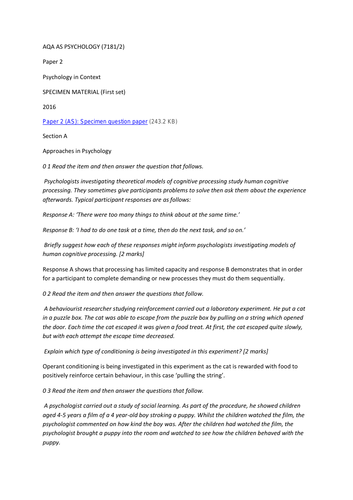

AQA AS-Psychology-7181/2 (New syllabus)
Featuring:
Section A : Approaches in Psychology
Section B : Psychopathology
Section C: Research Methods
This resource provides 2 examination specimen papers which demonstrate in a practical way how to get the best grade you can in your AQA AS exam for Paper 2.
Featuring answers to the following questions:
Section A
Approaches in Psychology
0 1 Briefly suggest how each of these responses might inform psychologists investigating models of human cognitive processing. [2 marks]
0 2 Explain which type of conditioning is being investigated in this experiment? [2 marks]
0 3 Outline what is meant by social learning theory and explain how social learning might have occurred in the procedure described above. [6 marks]
0 4 Discuss two limitations of social learning theory. [6 marks]
Section B
Psychopathology
0 1 Distinguish between obsessions and compulsions. [2 marks]
0 2 With reference to the study described above, what do the results seem to show about possible influences on the development of OCD? [4 marks]
0 3 Outline one cognitive characteristic of OCD and one behavioural characteristic of OCD that can be identified from the description provided by Steven. [2 marks]
0 4 Briefly outline one strength of the cognitive explanation of depression. [2 marks]
0 5 Outline and evaluate the behavioural approach to treating phobias. [12 marks]
Section C
Research methods
Identify the experimental design used in this study and outline one advantage of this experimental design. [3 marks]
0 2 Describe one other experimental design that researchers use in psychology. [2 marks]
0 3 Apart from using random allocation, suggest one way in which the psychologist might have improved this study by controlling for the effects of extraneous variables. Justify your answer. [2 marks]
0 4 Write a suitable hypothesis for this study. [3 marks]
0 5 From the information given in the description, calculate the number of participants in each group in Condition B. [1 mark]
0 6 Name a measure of dispersion the psychologist could use. [1 mark]
0 7 The psychologist uses the measure of dispersion you have named in your answer to question 0 6. State how the result for each condition would differ. [1 mark]
0 8 Explain how the psychologist could have used random allocation to assign the 15 participants in Condition B into the 5 groups. [3 marks]
0 9 Using the information given, explain how the psychologist could further analyse the data using percentages. [2 marks]
1 0 At the end of the study the psychologist debriefed each participant. Write a debriefing that the psychologist could read out to the participants in Condition A. [6 marks]
2251 words total for all questions and answers in this PDF document file.
Something went wrong, please try again later.
This resource hasn't been reviewed yet
To ensure quality for our reviews, only customers who have purchased this resource can review it
Report this resourceto let us know if it violates our terms and conditions.
Our customer service team will review your report and will be in touch.